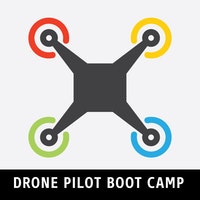This article was originally published on the Heatspring Blog.
In February 2015, the Federal Aviation Administration (FAA) released a list of proposed regulations that paved the way for small drones (or “unmanned aircraft systems”) to enter mainstream civil aviation. The regulations came after many close calls or accidents involving drones, including the January 26, 2015 accident when a drone crash landed on the White House lawn. Just months before the incident, in September 2014, a drone crashed in front of German Chancellor Angela Merkel. These accidents were not seen as intentional, but they raised concerns about the safety of drones.
 The FAA’s regulations, now known as 14 CFR Part 107, don’t provide for enough safety, says Keven Gambold, the instructor for HeatSpring’s new Drone Pilot Boot Camp course.
The FAA’s regulations, now known as 14 CFR Part 107, don’t provide for enough safety, says Keven Gambold, the instructor for HeatSpring’s new Drone Pilot Boot Camp course.
Dangerous Federal Regulations
“You only have to pass a two-hour multiple choice quiz online to become a commercial drone pilot,” he says. There is no requirement for future drone pilots taking the FAA test to have ever even seen or interacted with a drone.
“Those in the know think it’s a dangerously low bar,” he says.
According to the FAA, first-time drone pilots must be at least 16 years old, able to read, speak, write and understand English, and be physically and mentally able to safely fly a drone. They must also pass the initial aeronautical knowledge exam. This exam covers regulations related to small unmanned aircraft system rating privileges, limitations and flight operations, airspace classification and operating requirements, emergency procedures, radio communication procedures, airport operations and other topics.
After completing the exam, aspiring commercial unmanned pilots complete FAA Form 8710-13 for a remote pilot certificate using the FAA Integrated Airman Certificate and/or Rating Application system and receive their Part 107 card in the mail a few weeks later. That’s all they need to do for the next two years before a renewal test.
Increasing the Safety of Drone Flights
While the FAA test is the legal minimum required to operate a drone, it’s not really enough, says Gambold. With additional knowledge, pilots could substantially increase the safety of their drone operations.
That’s where HeatSpring’s Drone Pilot Boot Camp comes in.
“Flying commercially is a terribly complicated ordeal. You need insurance and have to buy expensive sensors that are the same price as aircraft.” What’s more, drone users need to learn how to turn the photos they take into helpful data, he says.
A Deep Dive into Flying Drones Commercially
Gambold’s course teaches students to become licensed commercial drone pilots by starting with the training necessary to pass the FAA exam. Students then dive more deeply into topics that are more relevant to flying drones commercially, such as equipment preparation, insurance and advancements in drone and sensor technologies. The HeatSpring course delves further than just flying the drones, covering the types of drones pilots may be interested in and possible applications for drone technology in the commercial sector.
The second section of the course is all about learning how to actually use the drones in the field, from commercial job niche selection and marketing to “making the customer happy.” The whole process requires sensor and software selection, data gathering, image processing, report writing and final billing and future business development. All of these aspects are covered in the online course, with guidance for instructor-assisted practical exercises in the simulator and in real life.
The students also learn where they’re allowed to fly. Can you fly in your local, state or county parks? A good practice is to print out local regulations and carry them with you just in case you encounter park rangers, who may not be familiar with regulations and who could shut you down, Gambold says.
Getting Students Out in the Field
At the end of the course, students tell Gambold where they live and what they are interested in doing. “I pretend to be a client, and find a legal area for them to fly and find a job for them to do.” From there, Gambold and the student walk through gathering and sorting the data, and then completing a report.
“In this section it becomes more interesting because now students are producing pieces of work and I’m assessing them and sending students back out,” he says.
As a result of the class, Gambold says, students are much better equipped to safely fly drones than they would be if they simply studied for the FAA test.
“You walk away knowing how to avoid mistakes and how to actually make some money,” says Gambold.
Join the Drone Pilot Boot Camp
Come join Keven Gambold in a new instructor-led session of the Drone Pilot Boot Camp training program which begins next week!
Affiliate disclosure:
Some of the links in this article may be an affiliate link, which means Drone Outlook may get a commission for purchases made through some of the above links. You will not pay more when buying a product through the above links, and you may occasionally receive a lower rate through coupon codes negotiated by Drone Outlook on these links. Thanks for your support!
About Post Author
Affiliate disclosure: Some of the links in this article may be an affiliate link, which means Drone Outlook may get a commission for purchases made through some of the above links. You will not pay more when buying a product through the above links, and you may occasionally receive a lower rate through coupon codes negotiated by Drone Outlook on these links. Thanks for your support!


No responses yet